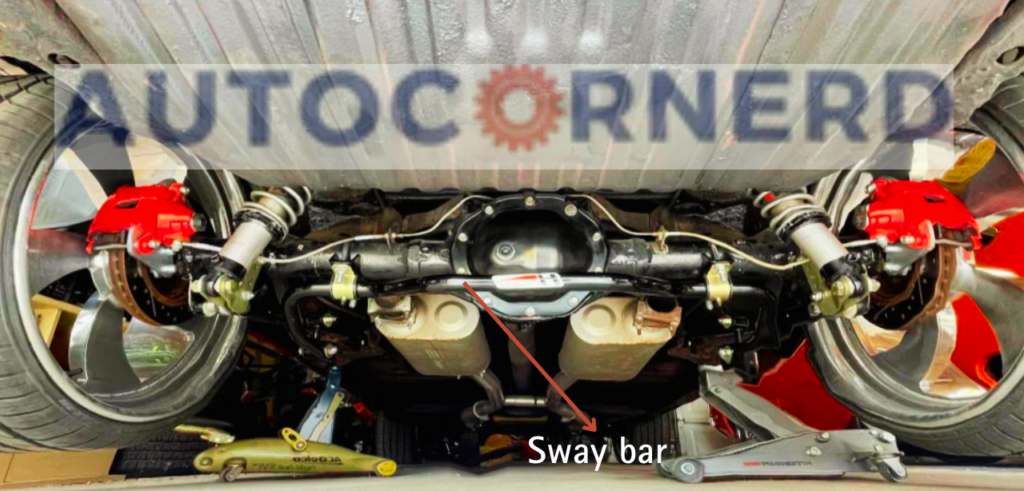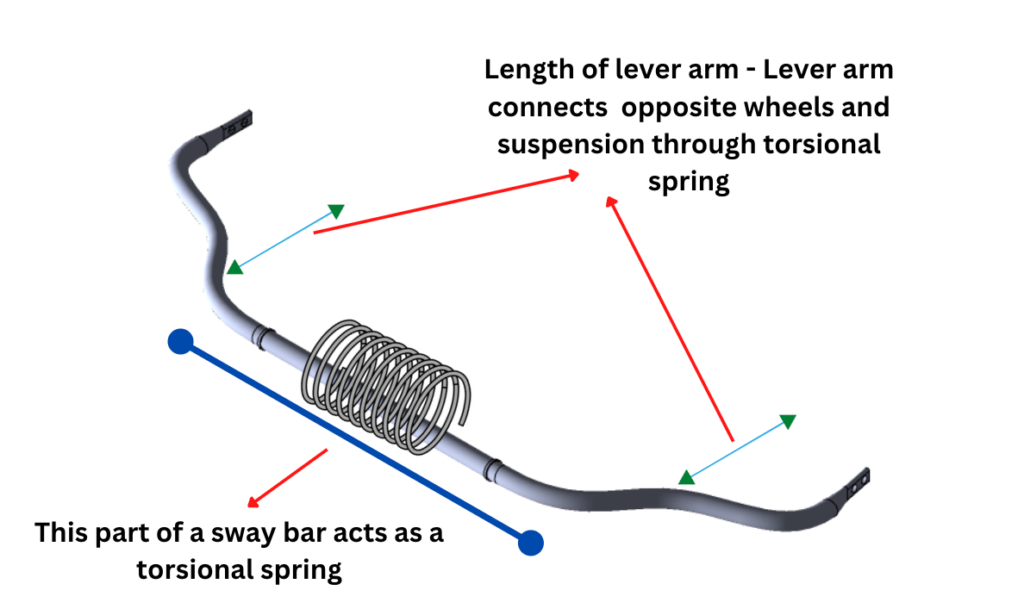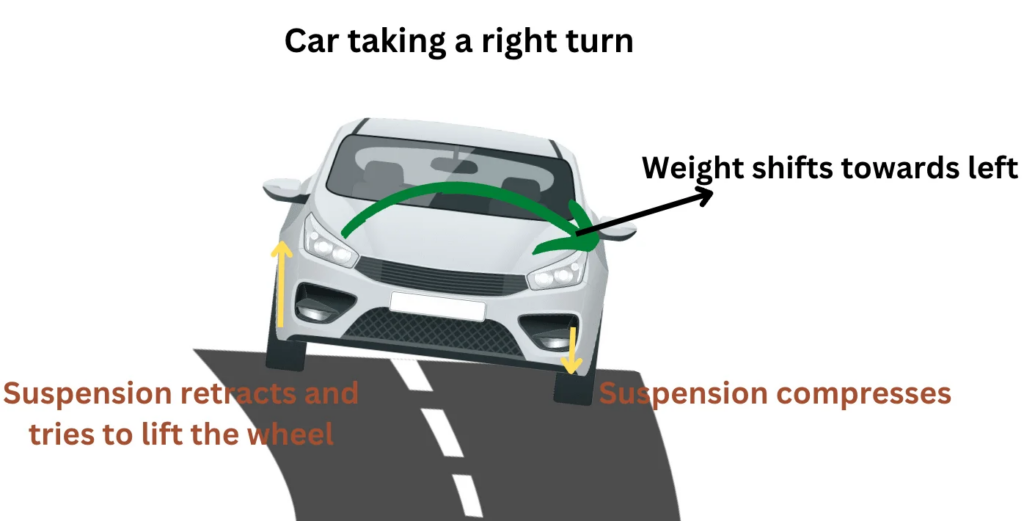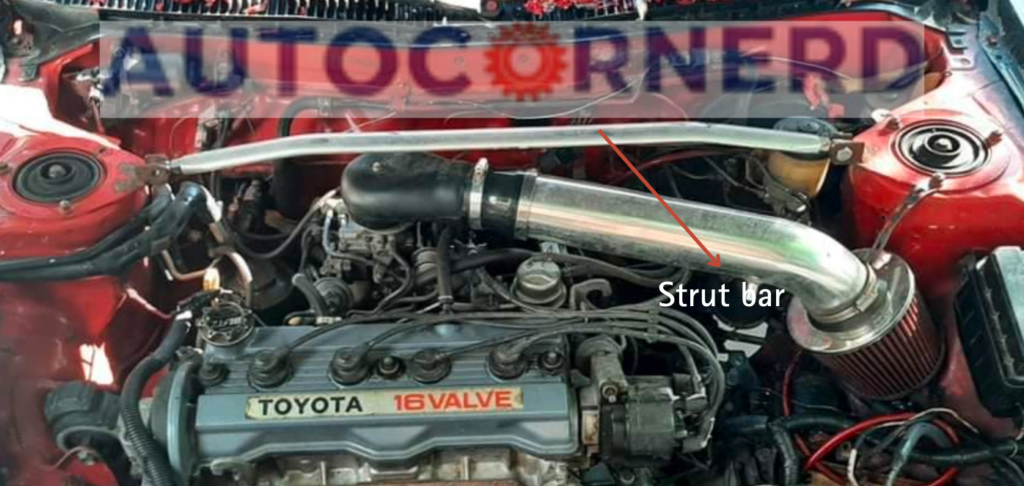Sway Bar vs Strut Bar: A Difference With Some Facts
Sway bars and strut bars are suspension components that improve vehicle stability. Sway bars connect the lower control arms and reduce body roll when cornering. Strut bars are chassis reinforcements that connect shock towers under the hood to reduce chassis flex. While both add stiffness, sway bars specifically counteract body roll whereas strut bars brace the chassis.
Both sway bar and strut bar are used to control the body movement of a vehicle. But what is the difference between sway bar and strut bar? In this guide, we will discuss sway bar vs strut bar and which one is best for your vehicle.
Tie rod is also a critical component of a car’s steering and suspension system. You can read my guide on how far can you drive on a bad tie rod for more details.
- Sway bars and strut bars improve vehicle stability, but work differently. Sway bars reduce body roll when cornering. Strut bars brace the chassis to reduce flex.
- Sway bars connect lower control arms side-to-side. They act like torsion springs to keep the suspension level when cornering.
- Strut bars connect shock towers. They absorb chassis flex when turning. More useful for lightweight, older cars.
- Stiffer front sway bars reduce oversteer but increase understeer. Stiffer rear sway bars reduce understeer but can cause oversteer if too stiff.
What Is Sway Bar?

A sway bar is a U-shaped metal rod that links to the suspension system of both sides of the vehicle’s axle through control arms.
A vehicle can have a sway bar on either front suspension or rear suspension. However, most modern vehicles have sway bars on both front and rear suspension.
Here is what a user says:
“All FWD sports cars come with front sway bars, it’s usually the rears that are missing. My CRX has front and rear standard sway bars. The civic came with the front standard sway bar.”
Sway bar helps prevent a body roll of a vehicle during cornering, improving the stability and handling of a vehicle over rough terrains. Body roll occurs when one side of a suspension is compressed and the opposite end of suspension is extended during cornering.
The sway bar is located between the left and right wheels. When you are driving a car over rough terrains, the car will swing on one side or the other. The sway bar will limit the movement of the car so that it doesn’t sway too much.
A sway bar is just like a torsional spring that provides torsional rigidity and resists the twisting force. A sway bar works by resisting a twisting force applies to it when one wheel of a car moves up and the other wheel moves down. A sway bar forces to raise or lower the opposite wheels to the same heights to reduce the chances of tilting or rolling a vehicle.

When a car takes a right turn, for example, the weight of the car is shifted to the outside of the turn i.e. on the left wheels and the suspension system is compressed on that side.
So, the suspension will also try to push down that end of a sway bar. As a result, the wheels on the inside of the turn i.e. the right wheels will try to lift. So, in this case, one side of a suspension system is being compressed (moving down) and the other side of a suspension system is being extended (moving up due to the shifting of the weight of a vehicle’s body while taking a turn. This is where a torsional rigidity of a sway bar will come into play.
The sway bar will resist the lifting of the right wheels and prevent the vehicle from rolling by transferring the force to the suspension system of the inside wheels and compressing it as well. In this way, the sway bar will keep both sides of the car on a level plane.

Note: A sway bar doesn’t do anything when the suspension system on opposite ends moves up or down together. In this case, a sway bar will not twist and just move up and down with the suspension.
Stiffness Of A Sway Bar
There are many factors that determine the stiffness of a sway bar, including the material used, the length of the sway bar lever arm, and the cross-sectional area of the bar.
Increasing the cross-sectional of the bar will also increase its torsional rigidity i.e. its ability to resist the weight shift while taking a turn. If you double the diameter of a sway bar, the stiffness of a sway bar will increase by 4 times.
The shorter the lever arm, the greater will be stiffness of a sway bar. This is because, when the lever arm of a sway bar is shorter, the lesser force it will be going to put on the suspension system (shock absorbers).
This is the same as if you use a wrench with a shorter arm, you will need to apply more force to the wrench as the wrench transfers less force to the nut if its arm is shorter.
Similarly, a sway bar with a shorter lever arm will require a large amount of force to twist. So, if you double the length of a lever arm of a sway bar, the stiffness of a sway bar will be half.
Although the greater stiffness of a sway bar prevents the rolling of a vehicle, it also affects the comfort of driving.
A rigid stiff sway bar will cause the car to feel too stiff when you drive over the bumps. This is why cars can get a little squirmy on bumpy roads with stiffer sway bars.
With a stiffer sway bar, the suspension will be harder to compress, due to which you will feel every bump in the road.
That’s why the stiffer sway bars are mostly found in sports cars as these cars are driven at high speeds on smooth roads. So, rigid sway bars will ensure that they do not tip over when taking quick turns. On the other hand, off-road vehicles like Jeep Wranglers need to deal with the large bumps, due to which their sway bars are far less rigid than that of a racing car.
How Does Sway Bar Affect Oversteer and Understeer?
- A stiffer front sway bar will reduce oversteer and shift the car’s balance towards understeer.
- A softer front sway bar will reduce the understeer and shift the car’s balance towards the oversteer.
- A stiffer rear sway bar shifts balance to less understeer at the corner exit. If the rear sway bar is too stiff, it will cause an oversteer.
- A softer rear sway bar will increase understeer.
“Remember a basic principle that when we take more work from a tire than what it can deliver, it loses traction.”
Oversteer occurs when rear tires lose grip before the front tires and the car starts spinning out. Understeer occurs when the front tires lose their grip before the rear tires and do not respond to the input from the steering wheel anymore.
FWD cars are more prone to understeer as compared to RWD cars. This is because the front wheels in FWD cars are doing the multitasking i.e. they are providing acceleration, turning and braking. So, when front wheels are overworked, they start losing traction.
The grip of the tires of a car while taking a turn depends on the Tire Lateral Load Transfer Distribution (TLLD). Lateral load transfer occurs when a car takes a turn as its weight transfers from the center of gravity to the outer tires.
In this way, the outer tires carry more load than the inner tire. TTLD measures how lateral load is transferred between the opposite tires (left and right) from the rear to the front axle.
Tire lateral load transfer is the demand of relative side-to-side energy control placed upon the tires. Since a stiffer sway bar reduces the deflection of the suspension system during the cornering of a car, the lateral loads between opposite tires will transfer at a faster rate.
Moreover, a stiffer sway bar on an axle will cause more weight transferred to that axle.
So, due to the rapid transfer of lateral load between the tires, additional demand is placed on the tires.
If you use a stiffer front sway bar, the lateral load transfer will be more towards the front of the car as compared to the rear axle, placing more demand on the front tires. Due to more demand on the front tires, their traction and grip decreases, thus causing understeer.
I know it might still sound confusing to you as there is physics involved in this concept. Basically, with a stiffer front sway bar, two things are happening:
- More weight is transferred from the rear axle to the front axle of the car.
- The lateral load transfer from the outside tire to the inside tire occurs at a rapid rate i.e. speed of weight transfer from the outside to the inside tire during cornering is increased due to a stiffer sway bar.
So, due to a heavy load on the front axle of the car and fast lateral load transfer, the traction/grip of the front tires will be affected.
In simple words, you’re demanding more work from the front tires than they can deliver in a certain time. As a result, the front tires couldn’t be steered quickly to change direction while taking a turn, causing the understeer.
Note: A stiffer front sway bar is suitable when a driver tends to be more aggressive with the steering. However, it will affect the performance of your vehicles in brake zones and over bumps. This is the reason racing cars have only front sway bars as they are not driven in brake zones.
In the same way, with a stiffer rear sway bar, more weight is transferred to the rear axle. The speed of lateral load transfer from outside to inside tires on the rear axle will also increase.
Since the steering wheel is linked with the front tires, front tires have a lesser demand and they can easily respond to the turning force of the steering wheel. And due to more demand from the rear tires, the rear tires will not be able to track behind the front tires but slide out the outside of the turn, which causes oversteer.
What Is A Strut Bar?

Strut bar or strut tower brace is a mechanical linkage that connects two shock absorbers of a car to its body. The strut bar is a structural addition to the vehicle’s chassis and is used to improve the handling of a vehicle by absorbing forces that are transferred through the suspension.
When a strut bar is attached to a vehicle, it reinforces the frame of the vehicle and increases its rigidity. This is particularly important in old, lightweight cars that are known for having a body roll.
In this way, the forces are distributed to both sides of the vehicle’s frame and the flex in the chassis is reduced. You will find a front strut bar in the engine bay of your vehicle that is connecting the strut towers and rear front bar in the hatch or trunk area.
Here is how strut bar looks in Honda WRX:

When the vehicle takes a turn, the wheels will lose contact with the ground and the vehicle will lean into the turn. Due to this, the car body will also flex and that flex is transmitted through the car’s frame.
Here, a strut bar will act as a beam anchored to the shock towers. Strut bar is a rigid beam that attaches to the frame of a car. It absorbs the energy of the flexing of the car’s body. It acts as a support for the suspension system.
Also, if you’re on low-quality and rough roads, strut bar will reduce deformations in the car’s body.
Strut Bars In MacPherson Suspension Systems
Strut bars are more useful in vehicles with MacPherson Suspension Systems because MacPherson suspension systems create sideways load on the vehicle’s body when it takes a turn.
These suspension systems have only lower control arm. MacPherson suspension is lighter than the Double Wishbone systems. MacPherson suspension systems are directly bolted to the vehicle’s body.
MacPherson suspension systems have a large vertical space available around the wheel hub, due to which they are suitable for FWD vehicles.
Moreover, vehicles with MacPherson suspension systems have trouble making contact with the ground during cornering. This is because MacPherson suspension is directly bolted to the vehicle’s body, due to which it is unable to keep solid contact with the road on all four wheels during cornering.
Due to direct contact of strut towers with body, the effect of movement of one wheel will also affect the other wheels. This is why, strut tower braces play key role in MacPherson suspension systems.
Wishbone suspension systems have two control arms of unequal length. The advantage of one control arm with a shorter length is that it will induce a camber gain.
While taking a turn, two control arms of unequal length will cause a negative camber in the outside tire (incline the tire inward) and a positive camber in the inside tire (incline the tire outward) so that tires of car stay on the ground.
The use of strut bars in MacPherson suspensions is well explained in the following YouTube video:
Downside of Strut Bars
However, the downside of a strut bar is that it can affect both ends of the vehicle’s frame if one side of frame is damaged.
If there is a strong lateral (directional perpendicular to the vehicle’s travel path) impact on one of the vehicle parts, the opposite part of the vehicle connected to the damaged part by a strut tower brace will also be subjected to deformation, since the shock wave is distributed through the strut tower brace.
Final Thoughts About Strut Bar vs Sway Bar
In short,
- Strut bar ties together strut towers and adds rigidness to the vehicle’s body. On the other hand, sway bar stiffen the lower suspension system by connecting lower control arms of left and right wheels.
- Rear strut bars can consume space of a vehicle’s trunk while sway bars don’t use any space of a vehicle.
- Sway bars prevent body roll during high-speed turning and yield oversteer or understeer depending on the vehicle’s situation like track width and tires while strut bars can just prevent flex in the vehicle’s body, especially if the vehicle is quite older or lightweight, thus improving traction while cornering.
Newer vehicles’ bodies are pretty stiffer. So, installing a strut tower brace will not make any difference in the vehicle’s handling. You will only feel the difference at the extreme end of handling with a strut tower brace.
Moreover, whatever modification you make to your car’s suspension system, it will highly depend on your driving style, the weight distribution of the car, the tires’s condition, and rear and front suspension stiffnesses.
You can mix and match between the front and rear sway and strut bars to find the perfect balance to see what works best.
